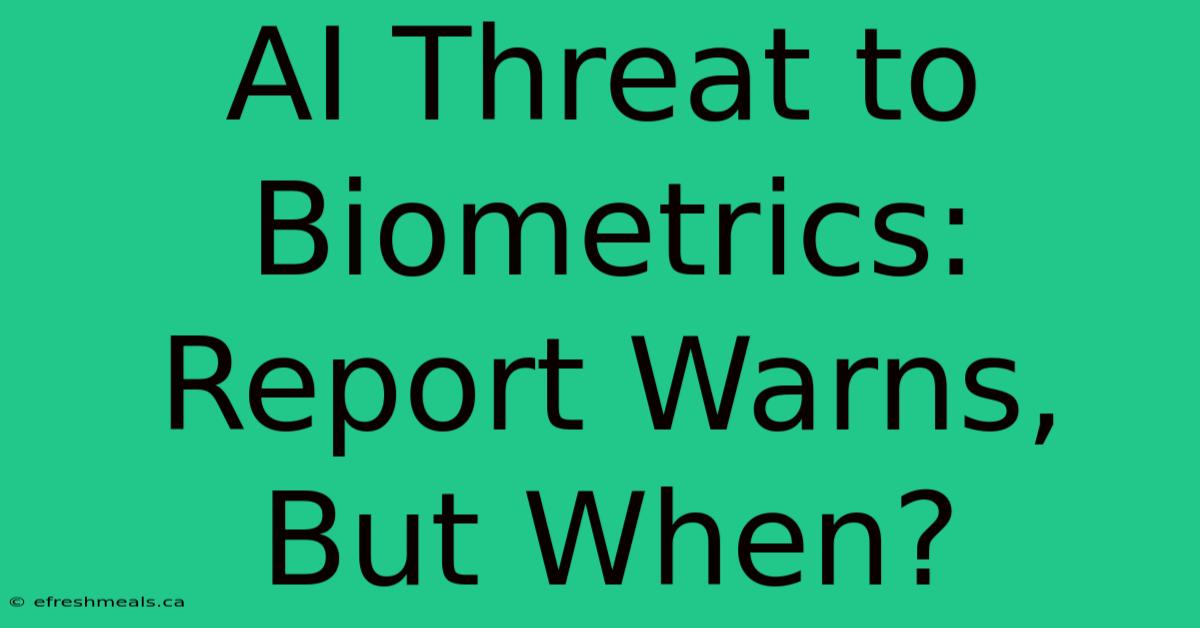AI Threat To Biometrics: Report Warns, But When?

Discover more detailed and exciting information on our website. Click the link below to start your adventure: Visit Best Website nimila.me. Don't miss out!
Table of Contents
AI Threat to Biometrics: Report Warns, But When?
Is AI poised to wreak havoc on the biometrics industry? A recent report raises concerns, but when should we truly worry?
The world of biometrics is changing rapidly. Facial recognition, fingerprint scanning, iris analysis—these technologies are increasingly integrated into our daily lives, securing everything from our smartphones to our borders. But a recent report throws a wrench into this picture, warning of an AI-driven threat to the very foundation of biometrics.
Why It Matters
This report highlights a critical question: Can AI technology be used to spoof biometric systems, potentially undermining the security they are designed to provide? The implications are far-reaching, impacting everything from identity verification to access control. If AI can be used to fool these systems, then the entire biometrics industry faces a serious challenge.
Key Takeaways of Biometric Security
| Key Takeaway | Explanation |
|---|---|
| Vulnerability to AI-based attacks | AI algorithms can be used to generate highly realistic synthetic biometric data that can fool authentication systems. |
| Importance of robust algorithms | Biometric systems need to be constantly updated and improved to stay ahead of evolving AI threats. |
| Need for ongoing research | Continued investment in research and development is crucial for addressing the vulnerabilities posed by AI. |
AI Threat to Biometrics: A Deeper Look
Deepfakes and Biometric Spoofing
Deepfakes, the hyper-realistic synthetic media created by AI, have become a cause for concern. These technologies can be used to generate artificial images or videos that mimic a real person's appearance, voice, or even biometric data. This opens up a new avenue for biometric spoofing, where attackers could potentially create fake fingerprints, iris scans, or facial images to gain unauthorized access.
The Evolution of AI-Powered Attacks
The threat is not just limited to deepfakes. AI algorithms can also be trained on massive datasets of biometric information to identify patterns and weaknesses in existing systems. This allows attackers to develop sophisticated methods for bypassing biometric authentication, even without access to advanced deepfake technology.
The Importance of Robust Algorithms and Continuous Updates
To counter these emerging threats, biometric systems need to be built with robust algorithms that can detect and reject synthetic data. This means incorporating AI-powered defenses, such as "liveness detection," which can distinguish between real and fake biometric samples. Continuous updates and improvements are essential to stay ahead of the ever-evolving landscape of AI-powered attacks.
Beyond Deepfakes: The Broader Implications
The potential for AI to compromise biometric systems raises broader questions about the future of security and privacy. If AI can be used to create fake identities and access sensitive information, it could have serious consequences for society.
FAQ
Q: When will this AI threat become a reality?
A: While the technology exists, the widespread deployment of AI-powered attacks on biometrics is still in its early stages. However, as AI technology becomes more sophisticated and accessible, the risk is likely to increase.
Q: How can we mitigate this threat?
A: A multi-pronged approach is needed, including:
- Developing stronger biometric algorithms
- Implementing AI-powered security measures
- Raising awareness and education about the risks
- Collaboration between industry and researchers
Q: Is biometrics still safe?
A: Biometrics remains a vital tool for security, but it's crucial to acknowledge the evolving threats posed by AI. By taking proactive steps to strengthen biometric systems and stay ahead of the curve, we can minimize the risks and ensure that biometrics remains a reliable and secure technology.
Tips for Secure Biometrics
- Use multi-factor authentication: Combining biometrics with passwords or PINs can add another layer of security.
- Be cautious of suspicious apps or websites: Avoid sharing biometric data with untrusted sources.
- Keep your devices and software updated: Software updates often include security patches that address known vulnerabilities.
- Stay informed about emerging threats: Stay updated on the latest advancements in AI and how they might impact biometrics.
Summary by Biometric Security
The report on AI threats to biometrics highlights a critical emerging issue. While the threat is not imminent, it's crucial to acknowledge the potential and take proactive steps to safeguard biometric systems. By strengthening algorithms, adopting AI-powered defenses, and maintaining a vigilant approach, we can ensure that biometrics continues to provide reliable security in an increasingly digital world.
Closing Message: As AI technology continues to evolve, its impact on biometrics will be a crucial factor in shaping the future of security. By understanding the threats and implementing proactive measures, we can navigate this evolving landscape and ensure the continued effectiveness of biometric systems.

Thank you for visiting our website wich cover about AI Threat To Biometrics: Report Warns, But When?. We hope the information provided has been useful to you. Feel free to contact us if you have any questions or need further assistance. See you next time and dont miss to bookmark.
Featured Posts
-
Ucp Membership Confirms Smiths Lead
Nov 03, 2024
-
November 2 Dewey Loses To Truman
Nov 03, 2024
-
What Happened On November 2 2024
Nov 03, 2024
-
Kamala Harris Surprise Snl Election Appearance
Nov 03, 2024
-
Arsenals Gabriel Back For Newcastle Match
Nov 03, 2024
